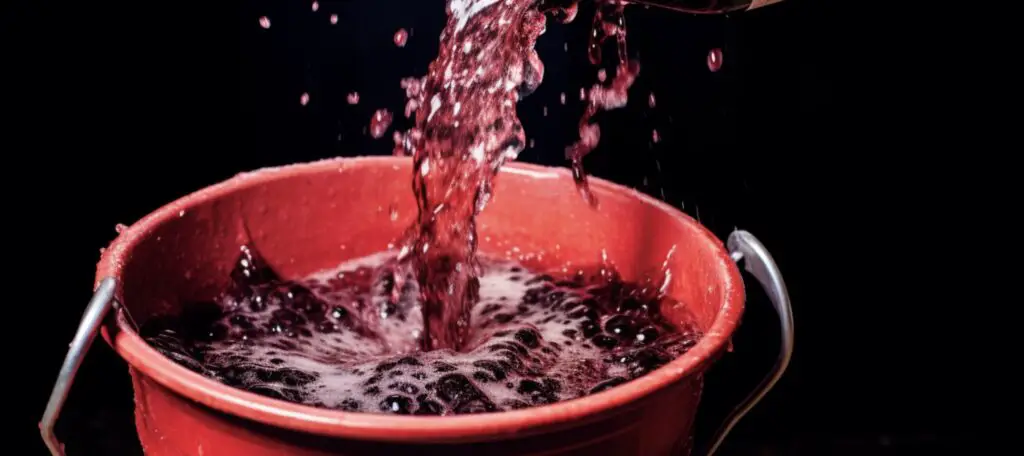Racking wine is an essential part of the winemaking process. It involves transferring the wine from one container to another, leaving the sediment behind.
This process helps to clarify the wine, improve its flavor, and prevent off-odors and off-tastes. However, many home winemakers may wonder: how do you rack a wine without a siphon?
The answer is simple yet requires some skill: you can rack wine without a siphon by using a gravity-based method or a pump-based method, depending on your resources and the volume of wine you’re working with.
Join me on this journey as we explore these methods in detail, along with some tips and tricks I’ve learned over the years.
Gravity Racking: How Does It Work?
Gravity racking is the oldest and most basic method of racking wine. It essentially involves using the natural force of gravity to separate the wine from the sediment.
To start, you need two containers: one for the wine and one to catch the clear wine. The container with the wine should be placed higher than the receiving container.

By carefully tilting the upper container, you can gently pour the wine into the lower one. Be sure to go slowly to prevent the sediment from being disturbed and ending up in the new container.
Equipment for Gravity Racking
When racking wine using gravity, it’s crucial to have the right equipment. Here’s what you’ll need:
- Two containers: You can use food-grade buckets, carboys, or demijohns. The size and type of container will depend on the volume of wine you’re working with.
- A stand or rack: This will help to elevate the wine container and allow gravity to do its work.
- A funnel: A large, food-grade funnel will make the process smoother and prevent spillage.
- A flashlight: This will help you see the sediment and prevent it from being transferred to the new container.
The Pump Method: An Alternative to Gravity Racking
If gravity racking seems too slow or cumbersome, you can also rack wine using a pump. This method is more efficient and less time-consuming, but it also requires more equipment and a bit more skill.

To rack wine with a pump, you’ll need a food-grade pump and tubing that fits snugly on the pump’s inlet and outlet.
The process is similar to gravity racking, but instead of relying on gravity, you’re using the pump to move the wine from one container to another.
Equipment for Pump Racking
If you decide to go with pump racking, here’s what you’ll need:
- Two containers: Once again, you can use food-grade buckets, carboys, or demijohns.
- A pump: You can use a manual or electric pump, depending on your preference and budget.
- Tubing: The tubing should fit snugly on the pump’s inlet and outlet.
- A power source: If you’re using an electric pump, you’ll need access to a power source.
Tips and Tricks for Racking Without a Siphon
Racking wine without a siphon can be a bit tricky, especially if you’re new to the process. Here are some tips and tricks I’ve picked up over the years:
- Go slow: Whether you’re using gravity or a pump, it’s important to go slow to prevent disturbing the sediment.
- Keep it clean: Always clean and sanitize your equipment before and after use to prevent contamination.
- Practice makes perfect: Don’t be discouraged if your first few attempts are less than perfect. With practice, you’ll get the hang of it.

Conclusion: Racking Wine Without a Siphon
Racking wine without a siphon may seem daunting at first, but with the right equipment and a bit of patience, it’s entirely doable.
Whether you choose to use gravity or a pump, the key is to go slow and keep everything clean.
To recap, here are the key points we’ve discussed:
1. Racking wine is a crucial part of the winemaking process.
2. You can rack wine without a siphon by using a gravity-based method or a pump-based method.
3. Gravity racking involves using the natural force of gravity to separate the wine from the sediment.
4. Pump racking involves using a pump to move the wine from one container to another.
5. The right equipment, including containers, a stand or rack, a funnel, a pump, and tubing, is essential.
6. Always clean and sanitize your equipment before and after use.
7. Whether you’re using gravity or a pump, it’s important to go slow to prevent disturbing the sediment.
8. Don’t be discouraged if your first few attempts are less than perfect. With practice, you’ll get the hang of it.
9. Always be mindful of the sediment and try to avoid disturbing it.
10. Racking wine without a siphon can be a bit tricky, but it’s entirely doable with patience and practice.
Happy winemaking!
FAQs
Can you rack wine by pouring?
Yes, you can rack wine by pouring. Racking is the process of transferring wine from one container to another, typically to separate it from sediment or to promote clarification. Pouring the wine carefully and slowly allows you to separate the clear wine from any sediment or solids at the bottom of the container.
How do you siphon without an auto siphon?
To siphon without an auto siphon, you can use a simple method known as the “mouth siphon” technique. Here’s how you can do it:
1. Fill the container you want to siphon from with the liquid you wish to transfer.
2. Place the container at a higher elevation than the container you want to siphon into. This height difference will create the necessary gravity flow.
3. Take a clean, food-grade hose or tube and insert one end into the container with the liquid.
4. Submerge the other end of the hose into the container you want to siphon into. Make sure the hose is completely filled with liquid and there is no air trapped inside.
5. Place your mouth over the end of the hose that is in the container with the liquid.
6. Begin sucking on the hose to create a vacuum. Once the liquid starts flowing, quickly remove your mouth from the hose and let gravity continue the siphoning process.
7. Monitor the flow and adjust the height of the containers if needed to control the speed of the siphon.
Remember to exercise caution and avoid ingesting any of the liquid during the process. It’s also important to use food-grade materials and maintain cleanliness to ensure the safety of the transferred liquid.
How many times should you rack wine before bottling?
The number of times you should rack wine before bottling depends on various factors such as the wine’s clarity, stability, and desired flavor profile. However, as a general guideline, it is common to rack wine two to four times during the aging process. Each racking helps separate the wine from sediment, promotes clarification, and aids in flavor development. Ultimately, the decision on how many times to rack should be based on the specific characteristics and requirements of the wine you are producing.
How long to ferment wine before racking?
The duration of wine fermentation before racking can vary depending on the specific wine style and desired outcome. Generally, red wines are fermented for 7-14 days, while white wines can take 10-30 days. However, it’s important to monitor the fermentation process closely, as factors like grape variety, yeast strain, temperature, and desired flavor profile can influence the exact timing.
How long can wine sit in a carboy?
Wine can sit in a carboy for several months to a year, depending on various factors such as the type of wine, storage conditions, and desired aging.
What is the easiest way to rack wine?
The easiest way to rack wine is to use a siphon or a racking cane. Start by sanitizing the equipment and the receiving vessel. Place the vessel lower than the source container, ensuring a gravity flow. Insert the siphon or racking cane into the source container, being careful not to disturb the sediment at the bottom. Begin the siphoning process by either sucking on the tube or using a pump to create a vacuum. Allow the wine to flow into the receiving vessel, leaving behind any sediment. Be cautious not to introduce excessive oxygen during the transfer.




